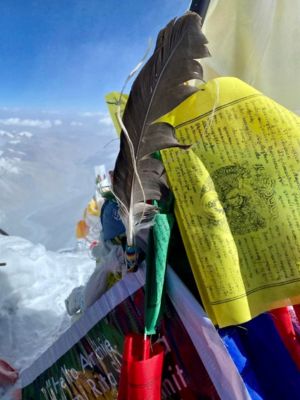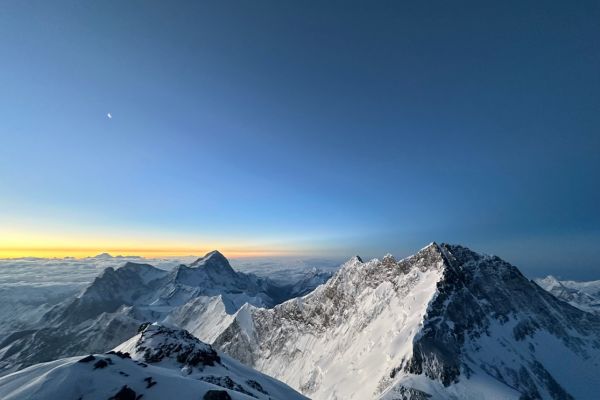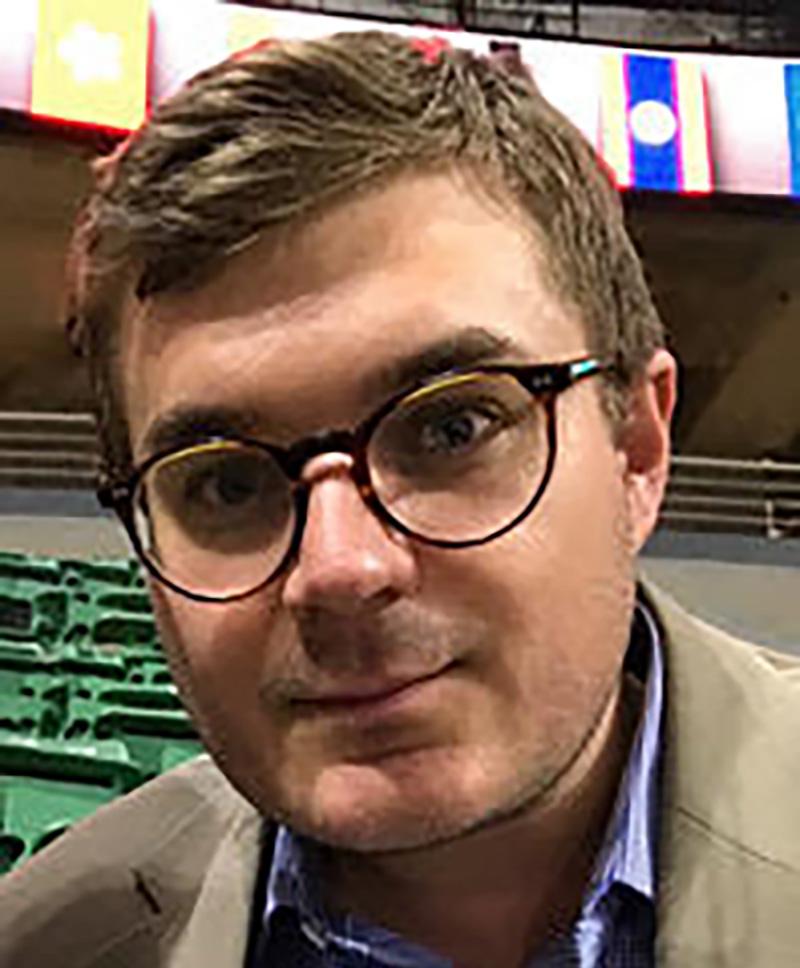
- Details
- By Ben Pryor
“You realize so strongly we are not meant to be here,” Weasel recalls the harsh realities of being at the summit of Everest. “The Earth does not want us here.”
At 29,029 feet (8,848 meters), Mount Everest is the world’s tallest mountain, perched between Nepal and Tibet in the Himalayas. The peak draws upwards of 1,000 mountaineers from around the world each year looking for a taste of the summit, which hundreds have died in pursuit of. So far this year, eleven people have died attempting to reach the summit.
He vividly expresses the hardships that confronted him on the mountain. The profound realization of his mortality, and the acute dangers he would face, were not fully comprehended until he reached the mountain.
“Until you step foot on that mountain, you have no idea how close to death you are,” Weasel said. “Even as a surgeon, having close contact with death fairly frequently, I experienced it completely personally on that mountain I didn’t anticipate.”
Despite the formidable challenges and the harsh realities encountered during his ascent, he reveals a contrasting moment of extraordinary beauty.
“But I will tell you, as much fury of the mountain that I experienced as I made my way, watching the sunrise and the shadow of Everest’s perfect pyramid projected onto the valley in the background was one of the most beautiful things I’ve ever seen, to the point where I can’t help but cry watching that,” Weasel said. “The tears freeze to your face. It was one of the most beautiful things I’ve ever seen.”
On his ascent, Weasel carried a meaningful eagle feather blessed by fellow Lakota citizen Rick Two Dogs, which he placed at the summit.
 Weasel carried an eagle feather blessed by a fellow Lakota citizen. (photo: Jacob Weasel)“He gave it to me and said, ‘This is a symbol of our people. And for all of the injustice and all the tragedy that we have faced in breaking the spirit of our people. I want you to take this and carry it to the top of the world as a symbolic gesture of raising the spirit of our people above all that we have experienced,’” Weasel said.
Weasel carried an eagle feather blessed by a fellow Lakota citizen. (photo: Jacob Weasel)“He gave it to me and said, ‘This is a symbol of our people. And for all of the injustice and all the tragedy that we have faced in breaking the spirit of our people. I want you to take this and carry it to the top of the world as a symbolic gesture of raising the spirit of our people above all that we have experienced,’” Weasel said.
The Push to the Summit
Merely a day before he reached the summit while ascending the treacherous Lhotse Face, Weasel experienced a heart-stopping incident. His guide, Lakpa Dendi, shouted, “Rock! Rock! Rock! Rock!”
“I looked up, and there’s this racket ball size rock that is just zooming towards me,” Weasel recalls. “I don’t have – but maybe half a second, if that – to respond. And then it strikes me in the left chest.”
The inherent danger lay in the rockfall originating from higher altitudes on the mountain, with rocks breaking free and careening down at speeds reaching 60-70 miles per hour. Despite the split-second blow, Weasel quickly discerned that the impact hadn’t resulted in a broken rib but instead left him with a painful bruise.
Above Everest’s “Death Zone” at 26,247 feet, the human body deteriorates rapidly due to the lack of oxygen. Climbers face many hazards, including frostbite, hypothermia, avalanches, and the risk of falling into crevasses. Additionally, rescue operations at high altitudes are immensely challenging and often limited.
“I calculated how many hours I have spent in the [death zone],” said Weasel. “And at first, I was like, ‘There’s no possible way because I calculated 63.5 hours. The normal recommendations are that nobody generally spends more than 24 hours. And I had spent almost on the cusp of three days in the Death Zone.’”
As Weasel scaled the mountain, he hallucinated images of his family in the rock formations.
“As I’m going up the rock formations that you see on the mountain, I see the faces of my children, who are now aged 16, 14, and 12,” Weasel said. “But I see their faces as young children when they were two to five years old, coming out of the rocks, and I see the face of my wife coming out of the rocks. I begin hallucinating the faces of my family as I’m climbing, and it doesn’t dawn on me what exactly is going on. In retrospect, it was probably some degree of high-altitude cerebral edema and some degree of anoxia (lack of oxygen), and some small degree of brain damage. Very serious in terms of looking back, I was probably very close, potentially, to dying.”
 Mt. Everest is the tallest peak in the world, standing at 29,029 feet. (Photo: Jacob Weasel)
Mt. Everest is the tallest peak in the world, standing at 29,029 feet. (Photo: Jacob Weasel)
Renowned mountaineer Lakpa Dendi Sherpa guided Weasel’s climb and played a pivotal role in Weasel’s summit of Everest. Dendi holds the world record for ascending Mount Everest three consecutive times in under 11 days.
“Summitting Everest with Dr. Jacob Weasel was an incredible and rewarding journey,” Lakpa Dendi Sherpa said. “It was an honor to guide him as he made history as the first Native American to conquer this majestic peak. Witnessing his determination, resilience, and passion for adventure was truly inspiring. Together, we embraced the challenges, celebrated the triumphs, and formed an unbreakable bond on the roof of the world. It was an extraordinary experience that will forever hold a special place in my heart.”
Gallup to Mount Everest
Born in Gallup, N.M., Weasel was raised in Omaha, Neb., before relocating to Rapid City in 2018 to begin his career as the first Lakota trauma surgeon.
“I wanted to show Lakota people, and I wanted to show Native kids everywhere, that they’re equally capable as anybody else to achieve whatever they want to climb,” said Weasel. “And to dream big dreams and to chase after them.”
Beyond personal achievement, his expedition served a greater purpose by raising funds for The Wopila Project, Weasel’s nonprofit organization. The project aims to gather $100,000 to construct a playground in Rapid City’s Lakota Homes neighborhood and an additional $75,000 to support the establishment of three women’s health centers in rural Nepal.
This year marks the 70th anniversary of the first Mount Everest summit, with Sir Edmund Hillary and Sherpa Tenzing Norgay on May 29, 1953. Reflecting on his motivations, Weasel explains that if not for the absence of a Native American person having previously summited Everest, he might not have embarked on this journey.
“The search and finding nothing regarding the first Native person and wanting to do it, not for myself. I had this long conversation with each of my children,” Weasel said. “‘I’m not going there to climb for me. I’m going there to inspire others to chase dreams of their own.’ I feel so grateful to be where I am and to be afforded all the grace and opportunities. I find myself in such a fortunate position.”
As a kid, Weasel experienced firsthand the hardships and brokenness many Native families face. He recognizes the obstacles that impede many dreams and the responsibility that comes with his achievement.
“There’s a responsibility to use it as an opportunity to uplift everybody else around you and to uplift some kid on Pine Ridge with dreams and potential,” said Weasel. “I want to look at him and say, ‘Listen. I believe in you. Chase after those things, and don’t let anybody or anything stop you from chasing after your dreams. And when you fall, get up. Because it happened to me again and again and again.”
More Stories Like This
Center for Native Futures Hosts Third Mound Summit on Contemporary Native ArtsFilmmakers Defend ‘You’re No Indian’ After Demand to Halt Screenings
A Native American Heritage Month Playlist You Can Listen to All Year Long
11 Native Actors You Should Know
Five Native American Films You Should Watch This Thanksgiving Weekend
Help us defend tribal sovereignty.
At Native News Online, our mission is rooted in telling the stories that strengthen sovereignty and uplift Indigenous voices — not just at year’s end, but every single day.
Because of your generosity last year, we were able to keep our reporters on the ground in tribal communities, at national gatherings and in the halls of Congress — covering the issues that matter most to Indian Country: sovereignty, culture, education, health and economic opportunity.
That support sustained us through a tough year in 2025. Now, as we look to the year ahead, we need your help right now to ensure warrior journalism remains strong — reporting that defends tribal sovereignty, amplifies Native truth, and holds power accountable.
 The stakes couldn't be higher. Your support keeps Native voices heard, Native stories told and Native sovereignty defended.
The stakes couldn't be higher. Your support keeps Native voices heard, Native stories told and Native sovereignty defended.
Stand with Warrior Journalism today.
Levi Rickert (Potawatomi), Editor & Publisher


